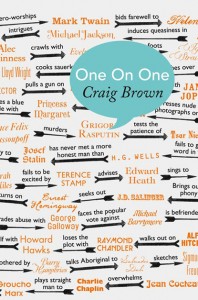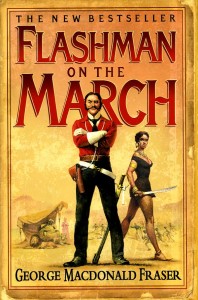You have no items in your cart. Want to get some nice things?
Go shopping
Having read some of the reviews, I’m looking forward to reading Craig Brown’s new book, One on One, where in short essays of only 1001 words, he tells of strange or chance meetings between famous people, from the 19th Century to the present day. In a way, although I’m sure that I’ll find all of it fascinating, I suppose that I really expect J.D. Salinger to come across Ernest Hemingway or Charlie Chaplin to play straight man to Groucho Marx. They are in the same line of work after all. You can even see Elvis Presley meeting President Nixon in the White House, though Nixon giving Elvis a Special Agent badge was probably unexpected. The ones that most intrigue me are the ones where you could ask yourself ‘How could that have happened?’. So I’m particularly looking forward to finding out about the meetings between H.G. Wells and Stalin and between Marilyn Monroe and Nikita Khrushchev, for example.
To meet famous figures from history is often the centrepiece of much historical fiction. Of course, some books may be just dramas set in a historical period, with not a famous character on any page, but in other books, well-known people are everywhere. If you’re in ancient Rome with Steven Saylor’s sleuth Gordianus the Finder in the excellent ‘Roma sub Rosa’ series, including books such as Roman Blood and Rubicon, you’ll come across Cicero and Julius Caesar. In Shakespeare’s historical plays, you’d expect to find Henry V and Richard III bestriding the stage. In Gore Vidal’s series of historical novels, such as Burr, Lincoln and Hollywood and now republished under the banner of ‘Narratives of Empire’, you come across Abe Lincoln and William Randolph Hearst at the height of their powers. The trouble I have with some historical fiction, though, is that if I’m familiar with the character, I start with a preconception, an idea of who they are and what they are about. Also, in many cases, I vaguely know the story and, in particular, how it ends. Abraham Lincoln, Julius Caesar – I just know it’s going to end in tears.
As a change, I’ve started to look into the subgenre of Alternate History, part historical, part science fiction. Here, you might know the characters but they didn’t die when you thought they did and the world they inhabit is often very different. It’s true, far too many of the books do seem to start with the premise that World War II ended differently but despite that, there is some excellent reading to be had. People have been writing about the ‘What Ifs’ of history for centuries, but acknowledged to be one of the earliest and greatest novels of the subgenre, Bring the Jubilee by Ward Moore was published in 1953. In this novel, the Confederate South had won the American Civil War and is now one of the world’s superpowers, with New York, on the losing side, a backward and unsophisticated place, even 70 years on. Without giving too much away, enter a historian with a desire to find out more about the Battle of Gettysburg and the possibility of time travel and you have an intriguing novel. There’s plenty more to be read here, with authors like Harry Turtledove, in books such as How Few Remain and American Front, rewriting the history of the last 150 years with the two protagonists in the American Civil War on opposite sides in future world conflicts. There are many websites that will tell you more about alternate history, with uchronia.net a good place to start.

The danger, unless your historical knowledge is firmly grounded, is that you might get to the point where you begin to confuse historical fact from the alternate, fictional view. In recent years, I’ve enjoyed the ‘Flashman Papers’ series, written by George Macdonald Fraser. Here he takes a fictional character, the bully Flashman from Tom Brown’s Schooldays by Thomas Hughes, and sees what happens to him after he left Rugby School. He joins the army but remains a bully and a coward, of course, with, these days, politically incorrect views about women, foreigners and, well, just about everyone. In the 12 books published, he romps through Victorian history, being promoted, knighted and awarded medals, all unjustly, and often managing to be present at pivotal moments in history from the Charge of the Light Brigade to the Battle of Little Big Horn. Plenty of historical characters feature throughout the series, from Florence Nightingale to Buffalo Bill, but one strange meeting really sticks in my memory. In Flashman and the Tiger, the hero, already a character taken from another work of fiction, actually gets to meet Sherlock Holmes, the great fictional detective, in the middle of one of his own mysteries, The Adventure of the Empty House.
It’s a strange meeting indeed.




